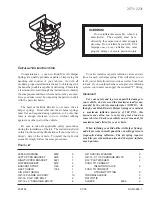
X
Have the tire sealant bottle replaced as
soon as possible at a qualified specialist
workshop.
X
Have the tire sealant bottle replaced every
four years at a qualified specialist work-
shop.
Battery (vehicle)
12 V battery – important safety notes
Special tools and expert knowledge are
required when working on the battery, e.g.
removal and installation. You should there-
fore have all work involving the battery car-
ried out at a qualified specialist workshop.
G
WARNING
Work carried out incorrectly on the battery
can lead, for example, to a short circuit and
thus damage the vehicle electronics. This can
lead to function restrictions applying to
safety-relevant systems, e.g the lighting sys-
tem, the ABS (anti-lock braking system) or the
ESP
®
(Electronic Stability Program). The oper-
ating safety of your vehicle may be restricted.
You could lose control of the vehicle, for
example:
R
when braking
R
in the event of abrupt steering maneuvers
and/or when the vehicle's speed is not
adapted to the road conditions
There is a risk of an accident.
In the event of a short circuit or a similar inci-
dent, contact a qualified specialist workshop
immediately. Do not drive any further. You
should have all work involving the battery car-
ried out at a qualified specialist workshop.
For further information about ABS and ESP
®
,
see (
Y
page 67) and (
Y
page 73).
All vehicles except vehicles with a lith-
ium-ion battery:
G
WARNING
Electrostatic build-up can lead to the creation
of sparks, which could ignite the highly explo-
sive gases of a battery. There is a risk of an
explosion.
Before handling the battery, touch the vehicle
body to remove any existing electrostatic
build-up.
The highly flammable gas mixture forms when
charging the battery as well as when jump-
starting.
Always make sure that neither you nor the
battery is electrostatically charged. A build-
up of electrostatic charge can be caused, for
example:
R
by wearing clothing made from synthetic
fibers
R
due to friction between clothing and seats
R
if you push or pull the battery across the
carpet or other synthetic materials
R
if you wipe the battery with a cloth
G
WARNING
During the charging process, a battery produ-
ces hydrogen gas. If a short circuit occurs or
sparks are created, the hydrogen gas can
ignite. There is a risk of an explosion.
R
Make sure that the positive terminal of a
connected battery does not come into con-
tact with vehicle parts.
R
Never place metal objects or tools on a bat-
tery.
R
It is important that you observe the descri-
bed order of the battery terminals when
connecting and disconnecting a battery.
R
When jump-starting, make sure that the
battery poles with identical polarity are
connected.
R
It is particularly important to observe the
described order when connecting and dis-
connecting the jumper cables.
R
Never connect or disconnect the battery
terminals while the engine is running.
Battery (vehicle)
361
Bre
akdo
w
n
assistance
Z
Summary of Contents for 2016 GLC
Page 4: ......
Page 32: ...30...
Page 82: ...80...
Page 238: ...236...
Page 306: ...304...
Page 307: ...Useful information 306 Stowage areas 306 Features 318 305 Stowage and features...
Page 325: ...Ensure that you do not pull on the cord Features 323 Stowage and features Z...
Page 338: ...336...
















































